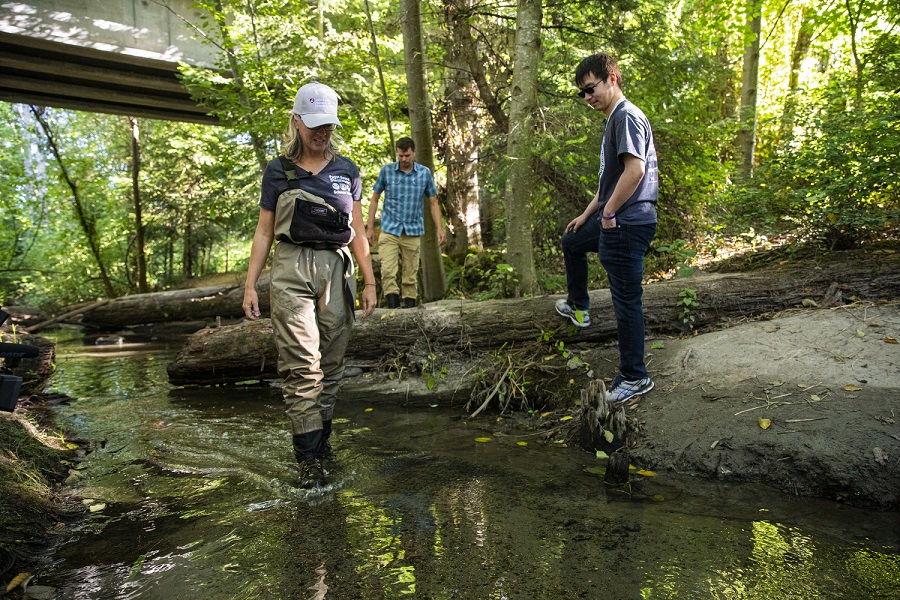
Every fall, coho salmon undertake an epic journey from the ocean back to Pacific Northwest urban streams and creeks to reproduce and die shortly after. But after heavy rain, researchers noticed more than half, and sometimes all, of the coho in a stream would suddenly die before they could spawn.
The mysterious deaths of coho salmon stumped biologists and toxicologists for decades. Various tests ruled out possible causes such as pesticides, disease, hot temperatures, and low dissolved oxygen. A team led by researchers at the University of Washington and Washington State University say they have finally found the answer—a very poisonous chemical related to a preservative used in car tires.
Researchers found the common ingredient reacts with ozone (a toxic gas) to form a poisonous chemical to the salmon. The team found evidence of this chemical in stormwater samples collected from urban waterways across the west coast.
The search for the coho-killer launched a multi-agency effort—led by NOAA-Fisheries, and including the U.S. Fish and Wildlife Services, King County, Seattle Public Utilities, and the Wild Fish Conservancy—to investigate the water quality of the creeks. They found that thousands of contaminants wash off roads whenever it rains, and tire wear particles are mixtures of hundreds of different chemicals. The challenge was to figure out which chemical was killing the salmon.
“Here we started with a mix of 2,000 chemicals and were able to get all the way down to this one highly toxic chemical, something that kills large fish quickly and we think is probably found on every single busy road in the world,” said co-senior author Edward Kolodziej, an associate professor in both the UW Tacoma Division of Sciences & Mathematics and the UW Department of Civil & Environmental Engineering.
Subsequent laboratory work on samples taken from urban streams around Puget Sound, and in King County, identified a substance called 6PPD, used as a preservative for car tires, as the chemical responsible for killing the fish.
“We knew that the chemical that we thought was toxic had 18 carbons, 22 hydrogens, two nitrogens and two oxygens. And we kept trying to figure out what it was,” said Zhenyu Tian, the study’s lead author and a research scientist at the Center for Urban Waters at University of Washington Tacoma. “Then one day in December, it was just like bing! in my mind. The killer chemical might not be a chemical directly added to the tire, but something related.”
It is still unclear how the chemical kills coho salmon and why it is so toxic. Researchers say it is likely an acute cardio-respiratory problem. In other words, it restricts their breathing like they are gasping for air. Another question researchers are exploring is what other species are sensitive to stormwater or the 6PPD-quinone chemical within, and outside, the Puget Sound region.
According to the study authors, better treatment and management of runoff before it enters coastal streams is part of the solution, but development of "green" chemical substitutes for 6PPD in tires is also needed.
Image credit: Mark Stone/University of Washington.
Researchers found the common ingredient reacts with ozone (a toxic gas) to form a poisonous chemical to the salmon. The team found evidence of this chemical in stormwater samples collected from urban waterways across the west coast.
The search for the coho-killer launched a multi-agency effort—led by NOAA-Fisheries, and including the U.S. Fish and Wildlife Services, King County, Seattle Public Utilities, and the Wild Fish Conservancy—to investigate the water quality of the creeks. They found that thousands of contaminants wash off roads whenever it rains, and tire wear particles are mixtures of hundreds of different chemicals. The challenge was to figure out which chemical was killing the salmon.
“Here we started with a mix of 2,000 chemicals and were able to get all the way down to this one highly toxic chemical, something that kills large fish quickly and we think is probably found on every single busy road in the world,” said co-senior author Edward Kolodziej, an associate professor in both the UW Tacoma Division of Sciences & Mathematics and the UW Department of Civil & Environmental Engineering.
Subsequent laboratory work on samples taken from urban streams around Puget Sound, and in King County, identified a substance called 6PPD, used as a preservative for car tires, as the chemical responsible for killing the fish.
“We knew that the chemical that we thought was toxic had 18 carbons, 22 hydrogens, two nitrogens and two oxygens. And we kept trying to figure out what it was,” said Zhenyu Tian, the study’s lead author and a research scientist at the Center for Urban Waters at University of Washington Tacoma. “Then one day in December, it was just like bing! in my mind. The killer chemical might not be a chemical directly added to the tire, but something related.”
It is still unclear how the chemical kills coho salmon and why it is so toxic. Researchers say it is likely an acute cardio-respiratory problem. In other words, it restricts their breathing like they are gasping for air. Another question researchers are exploring is what other species are sensitive to stormwater or the 6PPD-quinone chemical within, and outside, the Puget Sound region.
According to the study authors, better treatment and management of runoff before it enters coastal streams is part of the solution, but development of "green" chemical substitutes for 6PPD in tires is also needed.
Image credit: Mark Stone/University of Washington.